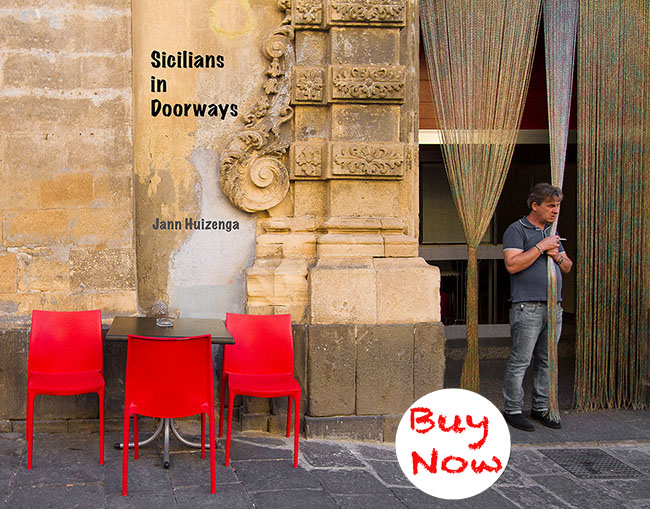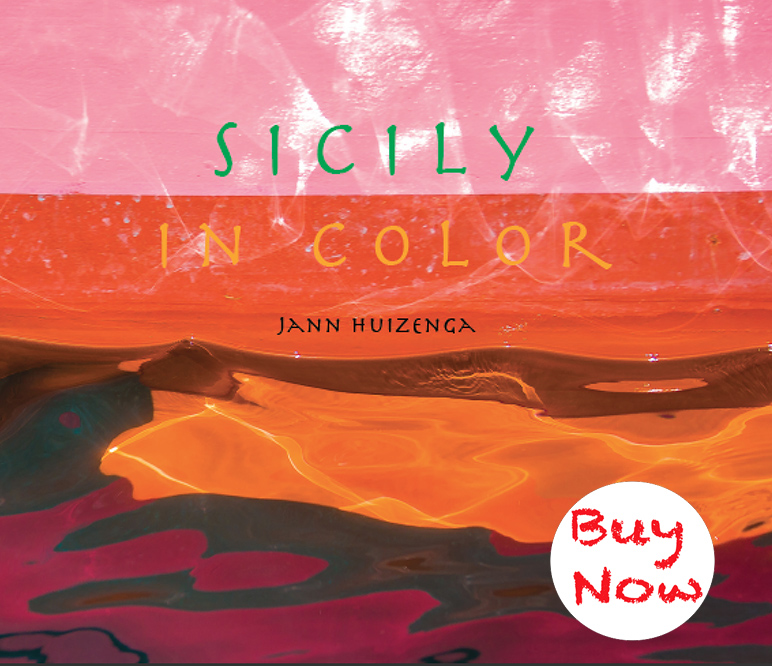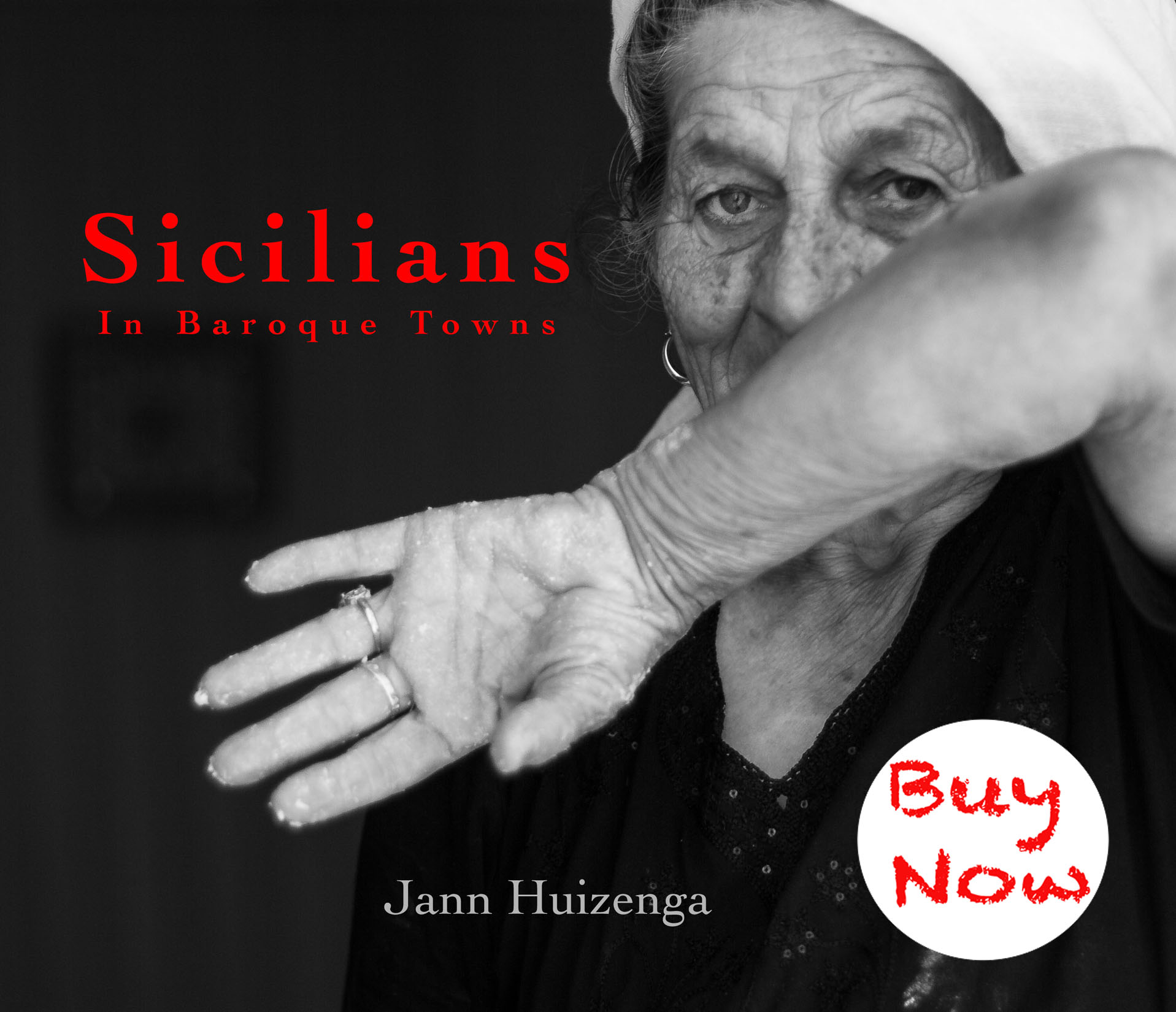___________________________
Shoes Like Gondolas
by Jann Huizenga
It took Sicily to teach her about fashion.
The best thing about my short-term rental in Ragusa, Sicily is that it comes with a cleaning woman. Lucia arrives every Monday morning sporting a strand of pearls, heels, and a pencil skirt. She doesn’t shed any of them, neither while mopping the stone floors nor while scouring the bidet. I work at the kitchen table in old sweats and listen to her click-clacking through the rooms like some sort of busy bar hostess.
Fare bella figura, which roughly translates to “cutting a fine figure,” endures as one of the highest Italian virtues, on a par with making a pilgrimage to the Pope. As the Sicilians say, L’onuri è fattu a li robbi, Honor is measured by your dress.
I am less honorable than my cleaning woman. Judged by the Sicilian proverb, dishonor dogs my entire nation. For it’s no secret that we Americans—who revere the gods of Comfort and Convenience and traipse through life looking as if we’ve just rolled off the La-Z-Boy to fetch another bag of Doritos—are fashion disasters. Everyone knows it, even the swarthy contadino at the Thursday Ecce Homo market who hawks socks and lacy black things I assume are funereal veils. “Beh, signora,” the disappointed man says when I settle on some socks after pawing through his bargain table, “Sono passate di moda, Those are out of fashion.” He holds aloft some pumpkin-and-acid-green numbers. “These here are fighe, cool!” How pathetic is it that I slavishly follow this old peasant’s fashion tip and buy a bagful?
While I’m shopping one day at Sma, my local supermarket—which also carries cheap clothes—a matron emerging from the dressing room collars me. “Mi scusi, signora!” she brays. “Does this skirt fit me right?”
“Si, signora,” I reply. “It looks good to me. But I’m American.”
“Ihh, mi sbaglio. Oops, I’m mistaken,” she stammers, and hotfoots it away from me toward a battleaxe with a fistful of salami. The attitude in a nutshell.
The topic of fashion comes up in class one day in the English class I’m teaching at the university. My student Davide posits that belts are political in Italy. “We cannot wear pants or even jeans in Italy without a belt,” he says. “Without one, you are a rebel against society.” Francesca adds that an increasing number of Italians make political statements with fashion. “If you’re right-wing, you put on Dior, Fendi, Gucci, or Pucci; if you’re left-leaning, you dress in Dolce & Gabbana.”
Well, either way you’ve spent a frickin’ fortune, I wanted to say, so what’s the diff?
“I’ve noticed,” Francesca goes on, “that Americans don’t care about fashion like we do. My Sicilian relatives who went to the States in the sixties send me a package of clothes every year at Christmas. But I stuff everything in the back of my closet. It’s always so ugly—and twenty years out of date!”
What interested me most about this conversation was not the fact that New World Sicilians cling to the image of Sicily as a backwater, or that going beltless here is tantamount to treason, but that these students enjoy discussing haute couture and fashion designers. Not exactly hot topics on American campuses.
***
The idea of comfort in clothing is as alien in Sicily as the notions of privacy and punctuality—I’m constantly combing the shops for stuff that’s actually wearable. All the street’s a stage, and she who shows up for a performance had better be decked out for the part. What this means in practice is that Italians dress in spectacularly chic garments that are utterly unwearable. Consider, if you will, the clothing in boutiques right now (all winter collections, though fall is piping hot). You find loads of straight skirts so constricting they allow only baby steps, unyielding leather pants, and strangling all-wool turtlenecks. The blouses look gorgeous but are made of fabrics so stiff and prickly that even their names itch—organza, chiffon, pointelle, piqué. It makes one crave the yummy cottons, terries, fleeces, and flannels of hang-loose America.
Everything that’s not all stiff and ruffly is metallic. Studded. Distressed to the max. The tag on one raggedy, hemless shirt I buy says, in English, “This garment have soul.” It seems nihilistic to pay top euro for threadbare duds that are just a wash cycle away from total disintegration. But then, much of the apparel here strikes me as pointless. I fondle a funnel-neck chenille sweater on a shop shelf, but when I go to try it on, I see the huge hole, like a vent, that has been cut from the back. For what? So you can warm your neck while air-conditioning your back? Most garments, in fact, contain some sort of peek-a-boo surprise—either a sleeve has gone missing, or both shoulders are absent, or the décolletage nose-dives to your navel, or the skirt is so itty-bitty that your bum droops below the hem. Nowhere, absolutely nowhere, can you find a plain old T-shirt. Non c’é!. They either drip with gaudy sequins or bear some unwearable English phrase like Party Monster or Ride Me.
***
Have you ever flicked through the pages of Vogue or viewed a haute couture show on Fashion TV and thought, “Amusing, but who in their right mind would actually wear that getup?” Italians would. Living in Italy feels, unnervingly, like walking through a gigantic theatrical production. Flamboyance and fantasia rule: faces painted like Mommy Dearest, dark hair garishly frosted and hennaed, frippery baroque and showy. There’s none of that American concern with looking “naturally” beautiful. I mull this over and develop a theory: Americans primp for close encounters, while Italians preen for spectators—fellow paraders in the evening passaggiata or distant admirers in a sidewalk caffè.
It’s almost impossible to find apparel without animal skin, feathers, or fur. Glamour and dead critters seem intertwined in the Italian imagination. Shops overflow with crocodilian belts, kangaroo-skin skirts, pony-skin pants, python pumps, bags with deer-antler handles. A friend once told me she regretted the short Sicilian winter because it allowed only a few months to enjoy her rabbit-fur coat. As I admire Pinocchio pants (what we call capris) trimmed with gray fuzz—caterpillar?—at my local Stefanel shop, I ask the clerk if it’s real fur. “Well, of course, signora!” comes the reply. When I inform her I can’t buy the pants then, that Americans don’t much like real fur, she recoils in disbelief, as if I’d told her Americans run naked in the streets.
But I wax shrill. It would be wrong to give the impression I have no stomach for Italian fashion. Al contrario. I’m gradually replacing my dowdy Puritan wardrobe—hauled here in two heavy suitcases—with more sexational items. Not that I’m aiming for a sexpot look, mind you, but when you buy Italian threads, that’s just what you get. Midriff and cleavage and thighs are suddenly bared, you’re fettered in strings-lace-studs-chains—and Presto! You’re a southern Italian tart. It’s like playing dolls into adulthood—with yourself as Barbie.
Lest you wonder what a professional woman does with a sluttish wardrobe, well, she slips into it for work. A weatherwoman on Italy’s Channel 4 turned up on a recent show busting out of her blouse, looking more qualified to lap dance than read the weather. The louche cameraman—who must have been lying on the floor—slithered up her oily legs, then zoomed in and lingered wistfully on her ripe melons as the sober-suited anchorman raised his eyebrows and opined, “Nice dishabille.” In a sudden fit of modesty, she blushed and screened her upper body with her notes. On Channel 2, the news anchor wore a serious look and a black turtleneck sweater buttoned all the way to her chin one night as she delivered news of the disappearance of a little Sicilian girl and atrocities in Iraq. But what riveted me (though I tried to avert my eyes) was the hole in her sweater—big as a picture window—that showcased her ample cleavage. Maybe it’s just me, but eroticized news loses its gravitas.
During his year in Washington D.C., Milanese journalist Beppe Severgnini noted, in Ciao, America!, that working women there “go from their two-piece suit…straight into their husbands’ sweatshirts,” and concluded that the Eastern U.S. was “a strangely sexless land” where “feminine fascination is a no-no.” Scusi, Signor Severgnini; while you may be right about all that, can’t we find a happy medium between the sexless and the supersexed?
***
It wouldn’t be fair to gli italiani to say their obsession with clothing springs from narcissism. Elegance in Italy shows civic altruism: you are prettifying the landscape for the delight of your fellow citizens. As the old Sicilian saying goes, Mancia a gustu tò, càusa e vesti a gustu d’àutru; Eat to please thyself, but dress to please others.
In Sicily, even I take seriously my civic responsibility. I’m an idealized version of myself. I fuss over clothes and makeup, suck in my gut, walk taller. I have to get all glammed up even for a trash run because reaching the dumpster involves swimming through a sea of Sicilian eyes outside the Caffè Puglisi. Some days, I prefer to let the trash bags full of smelly fish bones and espresso grounds pile up in the apartment. It’s just too wearisome maintaining the façade.
***
The cowboy look is all the rage. Sicilian women attire themselves in pseudo concha belts, faux turquoise jewelry, and suede fringed jackets with whipstitching that would look phony even in Santa Fe, my hometown. Cowboy boots, called texani, sell like hotcakes. The shop windows show them in all heights, from little booties to thigh-high shit-kickers. I curse my luck. I left several pairs back home, never having considered including them in my luggage. Of course, my dusty boots are the real McCoy, which wouldn’t work here anyway. The wildly overpriced Italian versions are long—lunghissimo is the word that comes to mind—with toes that bow upward to resemble the prows of those Venetian gondolas that nearly capsize each summer from the weight of sneaker-shod americani.
I try on a pair. They’re distressed, fabricated to look like they’ve already put in years of hard labor out on the ranch. The box says, “Special feature! Damaged by hand.” The scimitar toes form angles so acute that all I can imagine as I hobble about is what great tools of self-defense they’d be if they didn’t kill me. “Molto sexy,” says the shopgirl with no trace of irony. Her own tootsies have been squeezed into a pink shoe so narrow that foot fat pours over the edges like yeasty dough.
When my Sicilian-American colleague, Mary, turns up one day shod in gondolas, I ask, “How can you walk in those things?”
“It’s actually easier than it looks,” she says, inching painfully down the street with me, arms akimbo. You have to have the balance of a circus performer to wear these things.
Sometime later, at a cannolo festival on the steep cobbled streets of Mary’s hometown, Modica, the prow of her shoe wedges itself between two cobbles. She lurches, her chocolate cannolo scudding through the air like a missile. I prop her up as she limps back down the hill. Despite all this, Mary deems my own footwear too sensible and insists I buy a pair of gondolas.
I cave. The cappuccino-colored shoes cost an eye from my head, as they say here, and have killer toes long as skis. “Looks like they’ll take you on a magic carpet ride,” says Husband when I get them home a month later.
***
Lest you conclude that women are the only fashionistas in Sicily, let me clarify: The real prima donnas are the men. On weekends, the passaggiata is all about black spandex T-shirts accentuating pecs and abs, starched white disco shirts, diamond studs in ears or noses. Chiseled jaws bristle with manicured stubble, heads are styled and gelled. Picture a pageant of white-hot young John Travoltas on the make. “Each thinks he is as handsome as Adonis,” writes D. H. Lawrence of Sicilian men in Sea and Sardinia, “and as ‘fetching’ as Don Juan.” They sashay like pimped-up poodles in a Mr. Sicily dog show. Megghiu moriri ca campari mali, goes another old Sicilian proverb: ‘Tis better to die than to live badly. These glamour-boys are just doing their part to make our lives worth living.
At midnight last week, after my British colleagues and I had had dinner out and were waiting for a cab, young men in their full Sicilian splendor were parading on the passeggiata. Bony Brendan sat hunched on the curb in a rumpled shirt, smoking a cigarette and eyeing the catwalk. “God, I hate these bloody Italian blokes,” he said.
I understand the sentiment, born of envy and an outsider’s sense of otherness. After six months in Palermo, I had jotted the following in my diary: These stunners are impeccably barbered, perfectly polished wax figures, the most self-conscious people I’ve ever seen. I’ve developed a passion for naturalness. For folks in dirty blue jeans and faces stripped of harlequin makeup. For people who do not daily turn themselves into works of art. For a cleansing hike through Peoria.
Since reading Luigi Barzini’s The Italians, I better understand the theatricality of Italian life, the importance of spectacle. [In Italy,] ugly things must be hidden…Everything must be made to sparkle, a simple meal, an ordinary transaction…must be embellished and ennobled with euphemisms, adornments, and pathos. These practices were not developed by people who find life rewarding and exhilarating, but by a pessimistic, realistic, resigned and frightened people. They believe man’s ills cannot be cured but only assuaged, catastrophes cannot be averted but only mitigated. They prefer to glide elegantly over the surface of life and leave the depths unplumbed.
More than other Italians, Sicilians know sorrow and fear. For millennia they’ve endured tyranny. Plague. War. Famine. Earthquakes. Burning at the stake. Volcanic eruptions. Abject poverty. Gangland-style murders. Excellent cadavers. So what if they want to caramelize life, gussy up and play-act? More power to them, I say. Still, McDonald’s has opened its doors in Ragusa. With Convenience moved into town, can Comfort be far behind?
As I revise this now, back home in the States, my gondola shoes gather dust in the dark recesses of my closet, along with most of my other Italian costumes—some have already gone to Goodwill. But I do have a new Italian look: I always, always, wear a belt.
Jann Huizenga has lived in Sicily on and off since 2002 and is at work on Kissing Sicilians: My Life in Ragusa, Sicily. This story won the Silver Award for Women’s Travel in the First Annual Solas Awards (2007) and appeared in The Best Travel Writing 2008.




